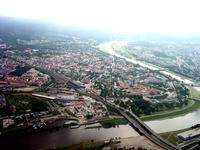You are in: Europe -> Germany -> Dresden Elbe Valley, and traditional search or Image Gallery will yield results of this site only
Dresden Elbe Valley
| Site number: | 1156 |
|
| Type of site: | Cultural | |
| Date: | 18-19th century | |
| Date of Inscription: | 2009(delisted) | |
| Location: | Europe, Germany, State of Saxony (Sachsen) | |
Up to 75 images are shown here. Click on each for more details or on Image Gallery for more images.
| Description: | The cultural landscape of Dresden Elbe Valley, which extends some 18-km beside the river from Übigau Palace and Ostragehege fields in the northwest to the Pillnitz Palace and the Elbe River Island in the southeast, was built in the 18th and 19th century. The area of low meadows is topped by the Pillnitz Palace and central Dresden, decked out with its numerous 16th-20th century monuments and parks. 19th and 20th century suburban villas and gardens and priceless natural elements also adorn the landscape. A number of terraced slopes alongside the river are still in use for viticulture, and some of the old villages have managed to maintain their historic composition and elements that date back to industrial revolution: particularly worth mentioning are the 147-m Blue Wonder steel bridge (1891-1893), the single-rail suspension cable railway (1898-1901), and the funicular (1894-1895). The passenger steamships of as far back as 1879 and the early 20th century shipyard are still used today. This site was inscribed in 2004, but delisted in 2009. --WHMNet paraphrase from the description at WHC Site, where additional information is available. | |
| The Dresden Elbe Valley is a World Heritage Site in Dresden, Germany. The valley, spreading some 20 kilometres through the city of Dresden, is one of the both cultural landscapes along the central-european river Elbe. This landscape gained its worth due to the fact that it is part of the urban area as well as part of the natural river banks and slopes. Famous parts of the Elbe Valley are Pillnitz with its castle and old village as well as the village of Loschwitz, technical building like the bridge Blue Wonder, the Standseilbahn Dresden or the Schwebebahn Dresden and the historic center with the famous buildings of Brühl's Terrace, Semperoper and Katholische Hofkirche (Roman Catholic Church of the former court). Parts of the area like Blasewitz are historic suburbs of the city while there are also industrial parts included. In 2006, UNESCO World Heritage Committee placed the site on its list of World Heritage Sites in danger and threatens to remove the Dresden Elbe Valley from the World Heritage List. Describing the committee's decision, the World Heritage Site reported that "plans to build a bridge across the Elbe would have such a serious impact on the integrity of property's landscape that it may no longer deserve to be on the World Heritage List. It therefore decided to inscribe Dresden Elbe Valley on the List of World Heritage in Danger "with a view to also consider, in a prudent manner, delisting the site from the World Heritage List in 2007 if the plans are carried through." Though the bridge was approved in a referendum in 2005 the city council decided on 20th July 2006 to stop the invitation to bid on contracts to build the bridge. --Wikipedia. Text is available under the Creative Commons Attribution-ShareAlike License. | ||
| Source: | http://whc.unesco.org/en/list/1156 | |
| Reference: | 1. UNESCO World Heritage Center, Site Page. | |































